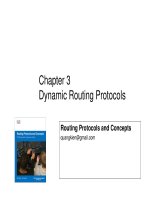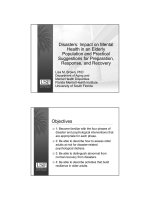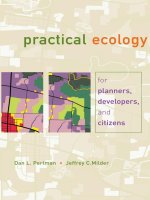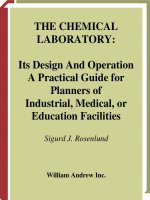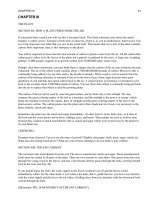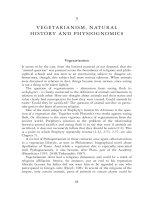Perlman - Practical Ecology for Planners, Developers and Citizens - Chapter 3 pptx
Bạn đang xem bản rút gọn của tài liệu. Xem và tải ngay bản đầy đủ của tài liệu tại đây (465.11 KB, 15 trang )
Imagine Exponentia, a booming city of the early twenty-first century. A hundred
years ago, Exponentia was a town of barely 5,000 residents; today, it has more
than 100,000, with most of that growth taking place in just the last half-century.
A large proportion of the city’s residents have high-tech jobs, and many of them
appreciate the easy access that the city has historically had to beautiful natural
areas. As a result of its recent growth, however, the town-become-city now ex-
tends well out into the neighboring farmlands, rangelands, and mountains and
has become part of a larger metropolitan complex (see Figure 3-1). Exponentia is
fictional, but cities like it can be found across North America; as you read the next
few paragraphs, imagine your local version of Exponentia and fill in the rele-
vant details.
Planners are familiar with many of the human challenges that accompany
rapid growth, such as the need to fund additional roads, schools, public safety
services, and water and sewer infrastructure. But how does urban growth affect
native species and habitats? The most obvious effect of the city’s expansion is the
loss of native habitat. This is a zero-sum game with three players: natural habi-
tats, agricultural lands, and urban land uses. As one land use expands—typically,
human-inhabited areas—one or both of the others contract. Granted, these are
not completely mutually exclusive categories; for example, lightly used range-
lands and sparsely inhabited regions can serve as good habitat for some native
species. But, by and large, every acre of the landscape can be assigned to one or
3
When Humans and
Nature Collide
When Humans and Nature Collide 37
another of the categories, and the unmistakable trend—and one that shows no
sign of changing—is that native habitat has been shrinking over time.
As the four diagrams of Exponentia shown in Figure 3-1 illustrate, human
development is not likely to occur in all areas equally. Development proceeds rap-
idly on relatively flat sites with well-drained soils, since these make good build-
ing sites. Development is slower to reach remote, steep, or poorly drained lands,
although homes may appear on hillsides and along ridgetops if local ordinances
allow. So, in this hypothetical example, while only about half of the total area has
been developed in the past fifty years, most of the flat lowlands have been lost,
while the hillsides remain relatively untouched.
Consequences of Human Settlement
As human settlements spread and our activities expand, we affect native biodi-
versity in many ways. Urban and agricultural land uses destroy and fragment
native habitats; our homes, machines, and industries pollute, degrade, and alter
the land, air, and water; we harvest (and often overharvest) native species from
their habitats; and we accidentally or intentionally introduce non-native species.
For example, since European settlement of North America, nearly all of the con-
tinent’s tallgrass prairie has been converted to agriculture. Most of the states and
provinces originally containing tallgrass prairie have lost 98 percent or more of
their prairie area.
1
Human impacts affect different regions in different ways, but
the cumulative effect—multiplied across landscapes and regions—is to change
the Earth in profound ways that are virtually irreversible on human time scales.
The remainder of this chapter explores these impacts, laying out the major eco-
logical challenges that this book will help readers address.
Habitat Destruction: Taking up Space
Habitat destruction occurs when native habitats are replaced by human land
uses, such as housing, commercial developments, and farmland. When this hap-
pens, resident plants and animals perish. Any animals that do survive the con-
version may seek refuge in adjacent areas, if suitable habitat exists, but these
refugees may be unable to find adequate food, shelter, or territory if the habitat
is already occupied and may perish as well. But not all examples of habitat de-
struction are alike in their consequences. The short-term ecological effect of habi-
tat destruction depends greatly on its thoroughness, while the long-term im-
pact depends also on the permanence of the changes.
The thoroughness of habitat destruction can be thought of as a continuum.
At one end of the spectrum are places like lower Manhattan or large-scale mono-
culture farms, where native habitats have been completely obliterated. Small ves-
38 HUMANS, NATURE, AND INTERACTIONS
Figure 3-1. This time series of figures shows urban expansion for the
hypothetical city of Exponentia from 1950 to 2000. As shown in this series,
development tends to occur first on prime, flat, productive sites, moving
later into more remote areas and those with environmental constraints.
When Humans and Nature Collide 39
tiges of open space may remain, but they are probably nothing like the native
habitats of the area. At the other end of the spectrum are human land uses that
retain large areas in their natural condition—for example, a campground situ-
ated within a native forest or a lightly cut woodlot. In the middle are suburbs,
parks, golf courses, college campuses, and low-intensity agricultural areas such
as pastures. The thoroughness of habitat destruction in these areas varies greatly
depending not just on the number of buildings constructed or the amount of
pavement laid but also on the amount and quality of native vegetation retained.
Measures commonly used in planning and development such as “percent green
space” are poor indicators of habitat retention because they fail to differentiate
intact native habitats from turfgrass and other manicured vegetation, which are
often a biological wasteland for native species.
The permanence of human land use changes depends both on the nature of
the changes and on the ability of the ecosystem to recover from them. In some
cases, the native habitats can regenerate naturally and relatively easily follow-
ing human land use changes. For example, much of the northeastern United
States is heavily forested today, even though most of this region was actively
farmed 100 or 150 years ago. Dirt roads, croplands, pastures, wooden houses, and
even old railroad beds can all be reclaimed by nature within decades, as can be
seen throughout the forests of New England (see Figure 3-2). These regener-
ated forests are not exact replicas of the presettlement forests, but their basic
structure and function are intact, as are most of their dominant plant species.
In other cases, humans have changed the land and its ecology so greatly that
restoring it to its original condition may be virtually impossible. In metropoli-
tan areas, where we have paved much of the landscape, the likelihood that large-
scale regeneration will occur within several generations is becoming more and
more remote. Farming can also alter the land on a near-permanent basis. In many
arid regions of western North America, intensive irrigation with groundwater
has led to soils becoming overly saline from the small amounts of salt that are
naturally found in groundwater. A 1996 report from the U.S. Natural Resources
Conservation Service found that at least 48 million acres (19 million ha) of crop-
land and pasture are currently affected by salinization, an area equivalent in size
to the state of Nebraska. The report notes that “reclaiming saline soils economi-
cally is difficult, if not impossible. Salinized soil is lost to agricultural production,
at least in the near term.”
2
We are certainly not suggesting that humans stop paving or irrigating alto-
gether but, rather, that planners and designers strive to limit activities and
changes that alter the land in severe and long-lasting ways. As the examples
above illustrate, land use changes that significantly alter an ecosystem’s physi-
cal substrate—soil—tend to be less reversible (or take longer to reverse) than
40 HUMANS, NATURE, AND INTERACTIONS
those that do not.
3
In addition, some ecosystems respond more severely than oth-
ers to outside perturbations (such as human activity) and tend to return to their
predisturbance condition more slowly once the perturbation ends. For example,
ecosystems where plant growth and soil formation are slow—such as deserts,
tundra, and alpine ecosystems—tend to take longer to regenerate after a distur-
bance. Finally, different biotic communities regenerate at different rates; the basic
structure of a prairie ecosystem may coalesce within several years (assuming that
the soils are in good shape), whereas an old-growth redwood forest might take
a millennium to form.
Although conservationists sometimes speak of extinction as the only per-
manent change that humans can effect, other impacts can change the landscape
for many generations. Planners, designers, and developers should be especially
careful about creating changes in nature that will not be undone in our grand-
children’s lifetimes.
Habitat Fragmentation: Being a Bad Neighbor
Habitat fragmentation occurs when urban and agricultural land uses divide
native habitats into discontinuous patches. A close examination of Figures 3-1a
through 3-1d shows that the native habitats around our hypothetical city,
When Humans and Nature Collide 41
Figure 3-2. This house near Lords Hill in central Vermont was abandoned many
years ago. As in so many places throughout eastern North America, the forest has
grown up around the house, covering what was once farmland.
Exponentia, did not disappear in wide swathes all at once; instead, they were nibbled
away incrementally and discontinuously as individual developments expanded
outward. When formerly contiguous native landscapes become broken into iso-
lated patches, several ecological problems can occur. In general, the smaller a habi-
tat fragment, the smaller the populations of resident species it can support. Small
populations are at much greater risk of extinction than large populations, and
once a population is extirpated from an isolated patch of habitat, the site’s isola-
tion decreases the chance that it will be recolonized.
Fragmented landscapes also have a high proportion of edge habitat, where
natural lands are influenced by adjacent urban or agricultural areas. These edge
areas are unsuitable habitat for many native species because they tend to have a
different microclimate and vegetation structure than interior areas as well as suf-
fering detrimental impacts from adjacent human land uses, such as noise, dust,
and agricultural chemicals. Also, the edge zone is often attractive to predators and
thus is a dangerous place for many native species. In fragmented habitats, many
open spaces that appear to contain native ecosystems may actually have limited
habitat value because they have such a high proportion of edge. The process and
effects of fragmentation are discussed in much more detail in Chapter 6.
Exotic Species: Bringing Unwelcome Friends
Since colonial days, North America has been overrun by exotic species (also
known as non-native species) introduced by humans. The number of exotic
species is especially high around ports and other coastal areas that were settled
early by Europeans; in these areas, up to a third of the plant species can be exotics
(see Figure 3-3). For example, according to the U.S. Geological Survey’s Status
and Trends of the Nation’s Biological Resources, the small, cold state of Massa-
chusetts has about as many exotic plant species as much larger and warmer Cali-
fornia and Florida—probably because of the hundreds of years that Massachusetts
ports have been receiving cargo and plants from around the world (Massachusetts
has 1,019 exotic plant species, while California and Florida have 1,113 and 1,017,
respectively).
4
Most non-native species exist in relatively low numbers and do not cause
major problems. However, some exotics spread rapidly, outcompeting native
species and even altering whole ecosystems. These are known as invasive species.
In his 1943 essay “What Is a Weed?” Aldo Leopold states that “good and bad are
attributes of numbers, not of species.”
5
While the definition of a weed is inher-
ently subjective, most invasive species share certain traits that make them espe-
cially problematic for native ecosystems. According to Leslie Mehrhoff, curator
of the University of Connecticut Herbarium, invasive species tend to have the
following characteristics:
42 HUMANS, NATURE, AND INTERACTIONS
1) Each plant produces large quantities of seeds or propagules;
2) The plants have very effective dispersal mechanisms;
3) The plants are readily established;
4) The plants grow rapidly;
5) The plants compete very effectively.
6
Some exotic species can cause amazing amounts of ecological mischief, and
a consensus is growing among biologists that exotic species are second only to
habitat destruction as a threat to North America’s native biota. Unlike housing
developments and industrial parks, exotic species are often able to infiltrate and
overwhelm native habitats before the general public becomes aware of the threat.
Many exotic plant species have been imported intentionally, for use either in gar-
dens or in erosion control and land reclamation projects—and some species, such
as kudzu, have been imported for both purposes (see Box 3-1). Unfortunately,
as international trade and travel increase, the problem of exotic species is likely
to worsen. Although only a small proportion of the many exotic species that
reach the shores of North America successfully establish populations, the flow of
species is so great that every year brings new problems.
Habitat Degradation and Pollution: Fouling Our Nests
Like all living organisms, human beings create waste materials. We breathe out
carbon dioxide and water vapor, and we excrete nitrogen compounds and undi-
gested food. When few humans live in an area, our wastes are simply part of
When Humans and Nature Collide 43
Figure 3-3. Every part of the United States has been invaded by hundreds of exotic
plant species, and some states have over 1,000 exotic plant species. The numbers indi-
cate how many exotic plant species are found in each state. (Redrawn from Michael J.
Mac et al., Status and Trends of the Nation’s Biological Resources, 2 vols. [Reston, VA:
U.S. Department of the Interior, U.S. Geological Survey, 1998].)
Box 3-1
A Few Notorious Exotic Species
Kudzu (Pueraria montana), a native of eastern Asia, is a perennial vine of the legume family. The
plant was first brought into the United States in 1876 for display as an ornamental vine at the
Centennial Exposition in Philadelphia; in 1935, the U.S. Soil Conservation Service pressed this
hardy vine into service to halt erosion on farmland and along roadsides, paying farmers to plant
it. Eleven years later, kudzu covered some 3 million acres across the South, an area the size of
Connecticut. In 1970, the U.S. Department of Agriculture listed the plant as a common weed,
and today more than 7 million acres in twenty-five states are infested with it.
1
While kudzu, with its blanketing, choking appearance, is impossible to miss, other invasive
exotic species, such as garlic mustard (Alliaria petiolata), can sneak into an area virtually un-
noticed. Some invasive species continue to be welcomed by the general public even long after
biologists become aware of how damaging they can be for native species. For example, purple
loosestrife (Lythrum salicaria) is widely planted as an ornamental even though it can escape cul-
tivation and take over wetland areas with impressive and dismaying speed. Fifty percent or more
of the native plant biomass in a wetland area can be replaced by loosestrife, which crowds out
rare and endangered native species and disrupts the life cycles of many animals that depend on
native plants. In some cases, entire wetlands can be covered by purple loosestrife.
2
Saltcedar trees (several species in the genus Tamarix) not only replace native wetland plants
in the arid West but actually change the physical habitat. Their deep roots appear able to draw
more water out of the soil than the native species they replace, and they concentrate salts from
the water in their leaves. Since they are deciduous, when they lose their leaves, the high salt
content leaches into the surface soil, creating conditions that are inimical to many native plants.
Finally, saltcedar grows in riparian zones and wetlands, disrupting these fragile and ecologi-
cally critical habitats.
3
Animals, too, can run amok when introduced to favorable habitats. Gypsy moths (Lymantria
dispar) were introduced to the Boston area in about 1869 to establish a silk moth industry on this
continent (the project failed entirely). When the moths escaped from the backyard of Ettiene
Leopold Trouvelot, the French painter and amateur entomologist who imported them, they began
ravaging the neighborhood. Early attempts to control the spread of the species using scalding
water and burning kerosene proved fruitless. In 1981, gypsy moth caterpillars defoliated 12 mil-
lion acres throughout the northeastern United States, and their range keeps spreading.
4
NOTES
1. R. Westbrooks, Invasive Plants, Changing the Landscape of America: Fact Book (Washington, DC: Federal Interagency
Committee for the Management of Noxious and Exotic Weeds, 1998), />Conservation/Invasive/intro.html.
2. Westbrooks, Invasive Plants.
3. National Park Service, “Saltcedar,” (accessed July 25, 2003); The Na-
ture Conservancy, “Element Stewardship Abstract for Tamarix,” />pdf (accessed July 25, 2003).
4. U.S. Forest Service, (accessed April 14, 2000; Web page no longer available); National
Agricultural Pest Information System (NAPIS), “Gypsy Moth Fact Sheet,” />facts.txt (accessed June 29, 2001).
normal ecosystem functioning, as are the wastes of other large animals. But when
we aggregate into cities and concentrate large volumes of waste, or when we cre-
ate and apply novel chemical pesticides or spread huge amounts of fertilizer on
our crops and lawns—then we cause problems.
The effects of pollution on biodiversity are sometimes readily apparent. For
example, Lake Erie and Boston Harbor both experienced radical ecosystem
changes and the loss of native species because of pollution from sewage and in-
dustrial waste, although both have subsequently recovered significantly after the
pollutant sources were addressed. But pollution also affects ecosystems in more
subtle ways, including by:
• altering the chemical balance of ecosystems in ways that favor invasive ex-
otic species or affect the competitive balance between native species
• weakening organisms so that they are more susceptible to natural threats
• eliminating certain pollution-sensitive species, often leading to cascading ef-
fects on other species
• reducing the structural diversity (i.e., the number of suitable subhabitats)
within ecosystems.
7
Overharvesting of Natural Populations: Being Gluttons at
Nature’s Table
Much of nature’s economy is based on the “harvesting” of one species by
another. Except for plants, which harvest their own energy from sunlight, most
of the species on Earth get their energy by feeding either on living organisms (as
herbivores and carnivores do) or on dead organisms or biological waste prod-
ucts (as decomposers and detritivores, such as bacteria, fungi, and some insects,
do). In fact, much of evolution consists of adaptations by species to become ei-
ther more efficient in their harvesting of other species or better at escaping being
harvested.
When a few thousand humans fish in a river the size of the Columbia or
search for nuts and berries in a forest the size of Delaware, we function like one
of several large-bodied, effective predators and herbivores in the ecosystem.
However, when we employ advanced technology, even the nineteenth century’s
relatively simple technology of trains, telegraphs, nets, and traps, we become
something quite different: we can cause the extinction of what was possibly the
most numerous bird species ever to live on the planet, the passenger pigeon
(Ectopistes migratorius). With today’s technology—fishing boats equipped with
sonar, global positioning systems, and highly effective nets; or chainsaws and log-
ging trucks—we can come close to wiping out species in any ocean or forest.
When Humans and Nature Collide 45
Global Climate Change: Changing the Rules of the Game
Even in areas where careful land management practices have kept floods and
erosion at bay, planetwide events may cause problems. The Earth’s climate ap-
pears to be warming significantly, almost certainly due to the increase in green-
house gases that humans have released into the atmosphere since the start of the
Industrial Revolution. Greenhouse gases, such as carbon dioxide (CO
2
) and
methane (CH
4
), are generated by various human and natural processes, especially
by the burning of forests and fossil fuels. In North America, electricity genera-
tion, transportation, and industrial production (in that order) account for most
greenhouse gas emissions.
8
While climate scientists are not yet certain what effects global climate change
will have at any given site, they are developing a strong consensus about the
overall pattern of effects. One of the more profound anticipated consequences is
the rise of sea levels, which would inundate low-lying coastal areas. Sea level rise
will result from three trends: the melting of the Antarctic ice cap as the global
climate warms (thus adding more water to the oceans), the expansion of the water
in the oceans as the temperature rises, and the creation of large icebergs that drop
from the Antarctic ice cap into the ocean. If especially large icebergs calve off into
the ocean, they will cause an immediate rise in sea level, just as the water level
rises when a person gets into a bathtub. This is not mere speculation. In March
2000, the largest iceberg seen in four decades split off from the Ross Ice Shelf in
western Antarctica. The berg was almost the size of Connecticut and measured
185 miles by 23 miles.
9
Climate scientists predict that, if atmospheric CO
2
levels continue to rise as
they have over the past 150 years, most of the United States will experience a 3°F
to 10°F (2°C to 5.5°C) temperature rise by the year 2100—in contrast to the 1°F
rise that occurred during the twentieth century.
10
The warming effects in north-
ern regions such as Canada and Alaska are expected to be even greater.
11
But the
predicted results of global climate change go far beyond a simple warming. Many
regions will experience significant drying as warmer temperatures cause more
water to evaporate from the land. As a result of the extra moisture in the air, some
areas will see increased rains—especially an increase in the very heavy rains that
cause flooding.
12
The distribution of ecosystem types is also expected to change
significantly as a result of the changes in temperature and moisture regimes. Al-
though strong consensus exists among climate scientists that significant changes
will take place, different computer models yield different predictions about the exact
changes that will occur and how these will affect different parts of North America.
The rapidly changing climate will cause problems for many species as the cli-
46 HUMANS, NATURE, AND INTERACTIONS
matic zones to which they are adapted either disappear or shift more quickly than
the species can move. Although some species that reproduce and disperse rapidly
will be able to expand or move their ranges as the climate changes, few tree
species will be able to migrate quickly enough to keep pace with rapid climate
changes. Some habitats, such as the highland forests of the Sky Islands in the San
Pedro watershed, could disappear entirely if the climate becomes too warm; their
current inhabitants might then go extinct if there is no cooler place to which they
can migrate. In addition, some ecologists are concerned that native species will
not be able to move their ranges because human land uses will block their way.
Such obstacles may render many nature reserves unsuitable for the species that
they were intended to protect. For example, in North America, large east-west ex-
panses of agricultural or urban land may impede the migration of forest species
that would otherwise be able to expand their ranges northward to adapt to a
warming climate.
Land use professionals should expect the effects of climate change to hit
home during the twenty-first century. Planners and other local government of-
ficials may face new challenges related to mitigating damage from storms, flood-
ing (especially in coastal areas), and other natural hazards; maintaining viable
public water supplies as local conditions become drier; and keeping residents safe
from wildfire in drier climates.
13
In regions where large parts of the economy
depend on the weather, climate change may be a serious economic threat; for
example, warmer temperatures in northern New England may threaten the ski
industry as well as possibly undermine fall tourism and spring maple syrup pro-
duction.
14
To protect ourselves from a warmer climate and more extreme weather
events, we may spend more on cooling, insurance, and public safety.
For most or all of the problems posed by global climate change, technologi-
cal solutions will be available—but at what cost? Does it make sense to create
an environment that is increasingly hostile to human survival and then spend
money to find clever ways to engineer around these self-inflicted problems? An
increasing number of world leaders think not and have already taken steps to
slow the rate of increase of greenhouse gas emissions into the atmosphere, with
the goal of eventually stopping and then reversing the increase altogether. But
even if we take immediate action to reduce greenhouse gas emissions, a lag of
several decades or even centuries will occur before some of the effects of the re-
duction of greenhouse gases are felt. During this time, warming will continue
along with the increase in severe weather patterns, and some climatic changes
may be effectively irreversible.
15
Efforts to reduce greenhouse gas emissions have
begun to take root at the local level throughout North America. Numerous state,
provincial, and municipal governments across the continent have drafted climate
When Humans and Nature Collide 47
change action plans that include such steps as making buildings more energy
efficient, encouraging modes of transportation that are less reliant on fossil fuels,
and even planting trees to remove CO
2
from the atmosphere. Another way of re-
ducing greenhouse gas emissions—high taxes on gasoline—has proven very ef-
fective in Europe, where the average fuel efficiency of vehicles is much higher
than in North America.
16
Powerful Effects of Local Human Activity
As we will discuss in Chapter 4, natural habitats are in a constant state of flux:
new plant material grows and soils are formed until a disturbance such as a large
fire or storm comes along to destroy much of the living and dead plant matter
(biomass) or to wash away soils. Over time, however, the total plant biomass in
most regions remains roughly constant, and the same can be said for the total
amount of soil. In contrast, humans in many areas create a constant, ongoing loss
of plant matter from the ecosystem by cutting forests and keeping them from re-
growing or by using natural landscapes as pastureland, allowing cattle, goats, and
sheep to graze in a way that prevents the plant cover from regenerating. The loss
of forest, shrub, or prairie cover from an area is in itself not unnatural, as all re-
gions experience some type of disturbance or another. What is unnatural—and
so difficult for nature to recover from—is the unending pressure that humans
sometimes apply. As a survey of some of the earliest sites of agriculture and civi-
lization reveals, such pressures can have effects that last for millennia.
In the 1920s and 1930s, spurred by the catastrophic soil erosion of the Dust
Bowl era, Walter Clay Lowdermilk of the U.S. Soil Conservation Service con-
ducted field studies of several cradles of civilization to see how early farmers had
managed their soils.
17
He discovered that a number of the areas that are today
deserts, such as portions of Israel, Egypt, Lebanon, Iraq, and China, suffered from
severe soil erosion after several centuries of agriculture and animal husbandry.
He found a few places in each of these currently desert regions that had been pro-
tected from overfarming and overgrazing, such as the sites of ancient temples
and monasteries. These sites held soils that were still able to support native vege-
tation much as it was thousands of years ago.
In China, Lowdermilk found that deforestation along the upper reaches of
the Yellow River had led to a massive accumulation of silt in the river’s course
and a concomitant rise in the river’s level.This rise required the building of huge
dikes to keep the river within its banks, but in 1852, the river burst through its
restraints and killed millions who lived within its floodplains, all as a result of ex-
cess forest cutting upstream. Elsewhere in his travels, Lowdermilk discovered re-
gions where soils on steep slopes had been carefully conserved for centuries or
48 HUMANS, NATURE, AND INTERACTIONS
longer—in some cases, by farmers annually carrying baskets of soil on their
backs from the lower portions of hillside fields to the upper, more erosion prone
reaches. Similar patterns have held in recent years; deforestation and other land
use changes in upstream areas have increased the severity of flooding down-
stream, as occurred along the Mississippi River in 1993 and in the Nicaraguan
lowlands during Hurricane Mitch in 1998.
18
Perhaps more remarkably, human land use patterns can change local and re-
gional climate over short time scales, sometimes in profound ways that affect the
viability of native ecosystems and local economies. Many of these effects are
linked to agriculture, which can change temperature and moisture conditions by
removing native vegetation or irrigating dry land. On the high plains of north-
eastern Colorado, for example, the conversion of grasslands to irrigated and dry
agricultural fields appears to have led to cooler, wetter conditions both in the
farmed areas and in distant mountain regions.
19
In southern Florida, extensive
draining of natural wetlands to plant vegetable, sugar, and citrus crops may have
led to an increased frequency and severity of winter freezes, one of which (in
1997) resulted in losses of more than $300 million and the displacement of
100,000 migrant farm workers.
20
This unintended consequence of agricultural
cultivation is ironic considering that farmers moved into southern Florida in the
first place to avoid damaging winter freezes. Cities can also essentially generate
their own weather systems, as their dark paved surfaces and rooftops absorb solar
energy and create urban heat islands. Compared to nearby rural areas, cities were
found to be 1°F to 6°F (0.6°C to 3°C) warmer and have 5 to 15 percent less sun-
shine, 6 percent less relative humidity, 20 to 30 percent lower wind speeds, and
5 to 15 percent more precipitation (including thunderstorms driven by local heat
convection).
21
As long as human beings actively counteract their impacts on the landscape,
we may be able to prevent broad-scale degradation for a time, but as the floods
of China, Nicaragua, and the United States, and the deserts of the Middle East,
reveal, it may be impossible to avoid a reckoning. The effects of humans on the
landscape have been recognized for millennia, as Plato, writing in 360
B.C.,
lamented: “There are remaining only the bones of the wasted body all the
richer and softer parts of the soil having fallen away, and the mere skeleton of
the land being left . . . now losing the water which flows off the bare earth into
the sea There may be observed sacred memorials in places where fountains
once existed.”
22
When Humans and Nature Collide 49


